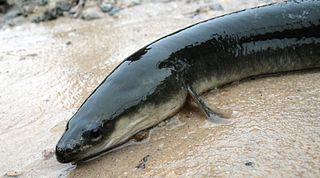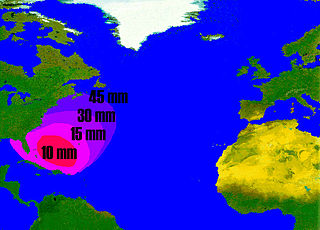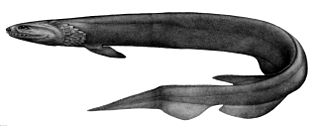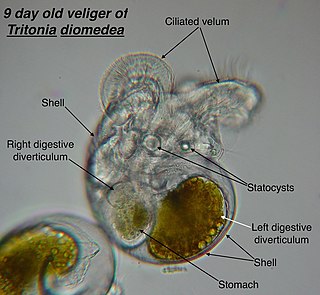
Metamorphosis is a biological process by which an animal physically develops including birth transformation or hatching, involving a conspicuous and relatively abrupt change in the animal's body structure through cell growth and differentiation. Some insects, jellyfish, fish, amphibians, mollusks, crustaceans, cnidarians, echinoderms, and tunicates undergo metamorphosis, which is often accompanied by a change of nutrition source or behavior. Animals can be divided into species that undergo complete metamorphosis ("holometaboly"), incomplete metamorphosis ("hemimetaboly"), or no metamorphosis ("ametaboly").

The European eel is a species of eel. They are critically endangered due to overfishing by fisheries on coasts for human consumption and parasites.

The American eel is a facultative catadromous fish found on the eastern coast of North America. Freshwater eels are fish belonging to the elopomorph superorder, a group of phylogenetically ancient teleosts. The American eel has a slender, supple, snake-like body that is covered with a mucus layer, which makes the eel appear to be naked and slimy despite the presence of minute scales. A long dorsal fin runs from the middle of the back and is continuous with a similar ventral fin. Pelvic fins are absent, and relatively small pectoral fins can be found near the midline, followed by the head and gill covers. Variations exist in coloration, from olive green, brown shading to greenish-yellow and light gray or white on the belly. Eels from clear water are often lighter than those from dark, tannic acid streams.

Eels are any of several long, thin, bony fishes of the order Anguilliformes. They have a catadromous life cycle, that is: at different stages of development migrating between inland waterways and the deep ocean. Because fishermen never caught anything they recognized as young eels, the life cycle of the eel is a mystery which has covered a long period of scientific history into the present day. Of significant interest is the search for the spawning grounds for the various species of eels and identifying impacts to population decline in each stage of the life cycle.

The frilled shark, also known as the lizard shark, is one of the two extant species of shark in the family Chlamydoselachidae. The frilled shark is considered a living fossil, because of its primitive, anguilliform (eel-like) physical traits, such as a dark-brown color, amphistyly, and a 2.0 m (6.6 ft)–long body, which has dorsal, pelvic, and anal fins located towards the tail. The common name, frilled shark, derives from the fringed appearance of the six pairs of gill slits at the shark's throat.

Teleostei, members of which are known as teleosts, is, by far, the largest infraclass in the class Actinopterygii, the ray-finned fishes, and contains 96% of all extant species of fish. Teleosts are arranged into about 40 orders and 448 families. Over 26,000 species have been described. Teleosts range from giant oarfish measuring 7.6 m (25 ft) or more, and ocean sunfish weighing over 2 t, to the minute male anglerfish Photocorynus spiniceps, just 6.2 mm (0.24 in) long. Including not only torpedo-shaped fish built for speed, teleosts can be flattened vertically or horizontally, be elongated cylinders or take specialised shapes as in anglerfish and seahorses.

Fish locomotion is the various types of animal locomotion used by fish, principally by swimming. This is achieved in different groups of fish by a variety of mechanisms of propulsion, most often by wave-like lateral flexions of the fish's body and tail in the water, and in various specialised fish by motions of the fins. The major forms of locomotion in fish are:

A veliger is the planktonic larva of many kinds of sea snails and freshwater snails, as well as most bivalve molluscs (clams) and tusk shells.

The pelican eel is a deep-sea eel. It is the only known member of the genus Eurypharynx and the family Eurypharyngidae. It belongs to the "saccopharyngiforms", members of which were historically placed in their own order, but are now considered true eels in the order Anguilliformes. The pelican eel has been described by many synonyms, yet nobody has been able to demonstrate that more than one species of pelican eel exists. It is also referred to as the gulper eel, pelican gulper, and umbrella-mouth gulper. The specific epithet pelecanoides refers to the pelican, as the fish's large mouth is reminiscent of that of the pelican.
The Anguillidae are a family of ray-finned fish that contains the freshwater eels. Except from the genus Neoanguilla, with the only known species Neoanguilla nepalensis from Nepal, all the extant species and six subspecies in this family are in the genus Anguilla, and are elongated fish of snake-like bodies, with long dorsal, caudal and anal fins forming a continuous fringe. They are catadromous, spending their adult lives in freshwater, but migrating to the ocean to spawn.

The superorder Elopomorpha contains a variety of types of fishes that range from typical silvery-colored species, such as the tarpons and ladyfishes of the Elopiformes and the bonefishes of the Albuliformes, to the long and slender, smooth-bodied eels of the Anguilliformes. The one characteristic uniting this group of fishes is they all have leptocephalus larvae, which are unique to the Elopomorpha. No other fishes have this type of larvae.

Snipe eels are a family, Nemichthyidae, of eels that consists of nine species in three genera. They are pelagic fishes, found in every ocean, mostly at depths of 300–600 m (980–1,970 ft) but sometimes as deep as 4,000 m (13,000 ft). Depending on the species, adults may reach 1–2 m (39–79 in) in length, yet they weigh only 80–400 g (2.8–14.1 oz). They are distinguished by their very slender jaws that separate toward the tips as the upper jaw curves upward. The jaws appear similar to the beak of the bird called the snipe. Snipe eels are oviparous, and the juveniles, called Leptocephali, do not resemble the adults but have oval, leaf-shaped and transparent bodies. Different species of snipe eel have different shapes, sizes and colors. The similarly named bobtail snipe eel is actually in a different family and represented by two species, the black Cyema atrum and the bright red Neocyema erythrosoma.
Neocyema erythrosoma is a species of pelagic fish, a deep-water bobtail snipe eel in the family Cyematidae. It is the only member of its genus, Neocyema. It was first described by Peter Castle in 1978 after two specimens were caught at great depths in the south Atlantic Ocean in 1971. Further specimens have since been caught in the North Atlantic.

The Japanese eel is a species of anguillid eel found in Japan, Korea, Taiwan, China, and Vietnam, as well as the northern Philippines. Like all the eels of the genus Anguilla and the family Anguillidae, it is catadromous, meaning it spawns in the sea but lives parts of its life in freshwater. Raised in aquaculture ponds in most countries, the Japanese eel makes up 95% of the commercially sold eel in Japan, the other 5% is shipped over by air to the country from Europe. This food in Japan is called unagi; they are an essential part of the food culture, with many restaurants serving grilled eel called kabayaki. However, presumably due to a combination of overfishing and habitat loss or changing water conditions in the ocean interfering with spawning and the transport of their leptocephali this species is endangered.

Leptocephalus is a genus that was used for species of larval eels, called leptocephali, that were thought to be new fish species, or whose adult eel species were not known. Leptocephali differ so much in appearance from their adults that the larvae and adults of eels are not easily matched, and when first discovered, leptocephali were thought to be a distinct type of fishes, but not eels. Because of this, the genus designation of Leptocephalus was used for a while for unidentified leptocephali even after it was known that these were the larvae of eels thus becoming a "wastebasket taxon", but this practice is no longer used. Examples of marine congrid larvae, found in the western Indian Ocean and the Red Sea that were named this way are listed below. Only two species in two families are currently treated as having any validity, though the validity of L. bellottii is strongly in doubt.

The European conger is a species of conger of the family Congridae. It is the heaviest eel in the world and native to the northeast Atlantic, including the Mediterranean Sea.

Eels are ray-finned fish belonging to the order Anguilliformes, which consists of eight suborders, 20 families, 164 genera, and about 1000 species. Eels undergo considerable development from the early larval stage to the eventual adult stage and are usually predators.

Tarpon are fish of the genus Megalops. They are the only members of the family Megalopidae. Of the two species, one is native to the Atlantic, and the other to the Indo-Pacific Oceans.

Fish go through various life stages between fertilization and adulthood. The life of a fish start as spawned eggs which hatch into immotile larvae. These larval hatchlings are not yet capable of feeding themselves and carry a yolk sac which provides stored nutrition. Before the yolk sac completely disappears, the young fish must mature enough to be able to forage independently. When they have developed to the point where they are capable of feeding by themselves, the fish are called fry. When, in addition, they have developed scales and working fins, the transition to a juvenile fish is complete and it is called a fingerling, so called as they are typically about the size of human fingers. The juvenile stage lasts until the fish is fully grown, sexually mature and interacting with other adult fish.
Congriscus megastomus is an eel in the family Congridae. It was described by Albert Günther in 1877, originally under the genus Congromuraena. It is a marine, temperate-water dwelling eel which is known from Japan and the Kyushu–Palau Ridge, in the northwestern Pacific Ocean. It inhabits reefs. Males can reach a maximum total length of 40 centimeters. This species' remarkably large and distinct leptocephalus larvae were previously known under the name Thalassenchelys coheni. In 2016, scientists used genetic techniques to link the larvae to the adult C. megastomus. These larvae reach a maximum size of 30 cm (12 in) and have a number of unusual characteristics, including two forward-facing front teeth that may be used for feeding on different prey than other eel larvae.

















